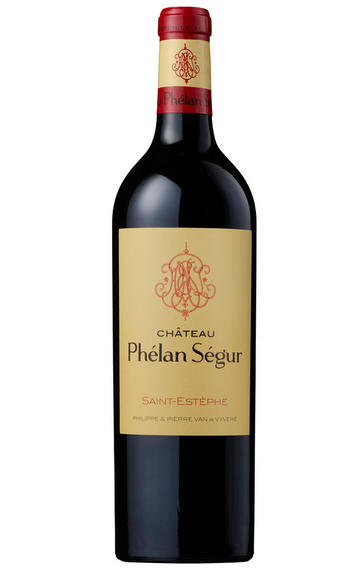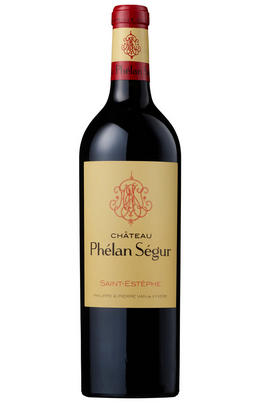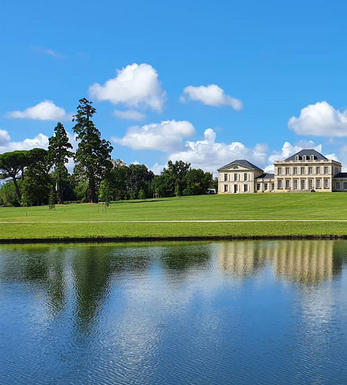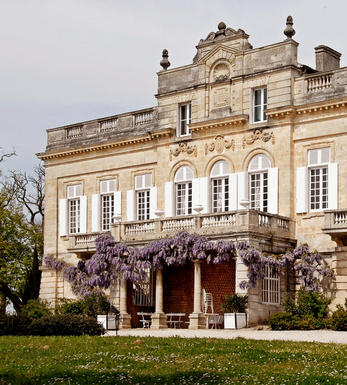
2022 Château Phélan Ségur, St Estèphe, Bordeaux

Critics reviews
The 2022 Phélan Ségur was picked between 14 and 26 September, 9 out of 13 days, with one plot immediately after another, using selected indigenous yeasts for around half the production. It was cropped at 28hL/ha with 14.2% alcohol; the pH is 3.8.
This year contains higher Merlot (56%) due to its higher yield than Cabernet (frost and berry size). On June 20 at 8.15 pm, three blocks were hit by horizontal hail and 25mm of rain within 10 minutes. This cost them 30% of production overall.
"We did less extraction at the end of the alcoholic fermentation and stopped the pumping over two days earlier at 1.010 [which, without getting too technical, is the Gravity of one litre of must relative to one litre of distilled water] and did more like an infusion."
Aged in 55% new oak, it has an enticingly pure bouquet with blackberry and bilberry fruit, blackcurrant, iris flower and light iodine scents. Very intense and focused. The palate is medium-bodied with svelte tannins and a liberal sprinkling of freshly cracked black pepper laced over the black fruit.
A quintessentially Saint-Estèphe with a structured and very persistent finish. Allowing the wine to open in the glass reveals impressive depth (more so than the 2019 and 2020) and precision. This will require several years in bottle, but it will certainly be worth the wait.
Drink 2030 - 2065
Neal Martin, Vinous.com (April 2023)
The 2022 Phélan Ségur is shaping up to be a gem. A burst of dark red/purplish fruit makes a strong opening statement. Sweet floral, spice and pomegranate caress the palate. The 2022 is immediately sensual and engaging. There is a bit of graininess in the tannin that is the only question mark here. This will be a fascinating wine to follow. Tasted three times.
Drink 2028 - 2047
Antonio Galloni, Vinous.com (April 2023)
Drink 2025 to 2035
Jane Anson, Inside Bordeaux (May 2023)
56% Merlot, 40% Cabernet Sauvignon, 2% Cabernet Franc, 2% Petit Verdot. Cask sample.
Dark- and red-fruit notes. Juicy fruit on the palate. Powerful but elegant at the same time. Plentiful tannins but finely honed. Lovely freshness. Persistent finish. Harmonious. 14.2%.
Drink 2030 - 2045
Jancis Robinson MW, JancisRobinson.com (May 2023)
Unwinding in the glass with aromas of cherries, crème de cassis, sweet berries and spices, framed by creamy new oak, the 2022 Phélan Ségur is medium to full-bodied, rich and concentrated, with plenty of sweet fruit and chewy structuring tannin. It's a persuasive Saint-Estèphe in a more modern, extracted style.
William Kelley, Wine Advocate (April 2023)
Loads of fruit here. Energetic, with layers of tannins. Full-bodied. It builds at the end and opens like a butterfly. Hints of minerals and iron. Best ever? 56% merlot, 40% cabernet sauvignon, 2% cabernet franc and 2% petit verdot.
James Suckling, JamesSuckling.com (April 2023)
A delicious and well-constructed wine from the Phélan team in 2022. Polished, balanced and just so drinkable - proximity to the river and clay soil helps keep freshness in the hot and dry conditions. A gorgeous texture straight away, clean and clear, juicy, vibrant and grippy with a chalky, flint and graphite element to the fine tannins.
You feel they've taken the best the vintage had to offer with a precise definition to all the elements; ripe bramble and cherry fruit, high acidity with a beautiful spiced and mineral signature from the St-Estephe terroir. A combination of power and charm that builds in structure and intensity while keeping a mouthwatering energy from start to finish.
A top buy - and could be upscored in bottle! Tasted four times throughout April and loved it every time. 2% Petit Verdot completes the blend. 3.8pH. 96IPT. Harvest took 13 days, from 14 - 26 September, whereas picking started on the 24th of September for the last three years. A yield of 28hl/ha. 75% grand vin production.
The team have also been working for the past few years on different fermentation yeasts to get more precision and a stronger link to the vineyards. 50% of production in 2022 was vinified using natural yeasts - five strains taken from five plots and used to vinify grapes from each of their respective parcels. Julien Viaud consultant. HVE/Terra Vitis.
Drink 2027 - 2039
Georgina Hindle, Decanter.com (April 2023)
I was lucky enough to be able to taste the 2022 Château Phélan Ségur on multiple occasions, and it always impressed, offering a deep purple hue as well as a ripe, powerful bouquet of darker currant and cassis-like fruits interwoven with leafy herbs, tobacco, and chocolate.
A ripe, full-bodied, opulent wine, it has beautiful tannins, a layered, concentrated mouthfeel, and a great finish. It’s going to be as good, if not better, than the 2018 and 2019, and I continue to love what director Véronique Dausse accomplishes at this address.
Jeb Dunnuck, JebDunnuck.com (April 2023)
About this WINE

Château Phélan Ségur
Château Phélan-Ségur is a St Estèphe property that produces textbook meaty, solid and long-lived St Estèphe. Founded by Irishman Bernard O’Phelan, the estate was developed by his son, Frank, and renamed Phélan Ségur in the early 20th century. It was bought by Xavier Gardinier in 1985 and run by his sons, Thierry and Laurent until 2018, when Philippe Van de Vyvere bought the property.
Phélan-Ségur's 70 hectares of vineyards are well-sited near the Grionde estuary, lying on well-drained gravel soils, bordered by those of Château Montrose and Château Calon-Ségur.
The grand vin is normally a blend of at least 60% Cabernet Sauvignon, with Merlot and a touch of Cabernet Franc and/or Petit Verdot. The grapes are fermented in temperature-controlled stainless steel vats and the wine is then matured in oak barriques (maximum 50% new) for 16 months. Phélan Ségur usually requires at least five to seven years of bottle ageing to show at its best, and the finest vintages can continue improving for up to 15 years.

Saint-Estèphe
Saint-Estèphe is the northernmost of the most important communes of the Médoc and borders Pauillac on its southernmost border, with only a gully and stream separates it from Ch. Lafite. To the north lies the Bas-Médoc.
Saint-Estèphe is defined by the depth of its gravel, which is ubiquitous but of varying depths and occasionally very shallow, when clay predominates. This keeps the soil cooler and wetter than its counterparts so that the wines can appear fresh in lighter vintages, but superbly successful in hot, dry years.
The best châteaux in the south of the commune have the deepest soil and the thickest gravel. Cos d'Estournel has an exceptional terroir with its vineyards being located on a south-facing ridge of gravel with excellent drainage.
Saint-Estèphe is the least gravelly of main Médoc communes and in the north of the commune the vineyards are heavier and more clay-based leading to a rustic style of wine being produced.
The wines can appear austere in youth with a discernable ferric note at some châteaux, but the best typically display good depth of colour, pronounced acidity an tannins in youth and are exceptionally long-lived. At their best, they are the equal of almost any Bordeaux. The well-regarded St Estèphe co-operative controls the production of about half the appellation.
Recommended Châteaux
Cos (Ch. Cos d'Estournel), Ch. Montrose, Ch. Calon-Ségur, Ch. Lafon-Rochet, Ch. Les Ormes de Pez, Ch. Beau-Site, Ch. Cos Labory, Ch. Phélan-Ségur

Cabernet Sauvignon Blend
Cabernet Sauvignon lends itself particularly well in blends with Merlot. This is actually the archetypal Bordeaux blend, though in different proportions in the sub-regions and sometimes topped up with Cabernet Franc, Malbec, and Petit Verdot.
In the Médoc and Graves the percentage of Cabernet Sauvignon in the blend can range from 95% (Mouton-Rothschild) to as low as 40%. It is particularly suited to the dry, warm, free- draining, gravel-rich soils and is responsible for the redolent cassis characteristics as well as the depth of colour, tannic structure and pronounced acidity of Médoc wines. However 100% Cabernet Sauvignon wines can be slightly hollow-tasting in the middle palate and Merlot with its generous, fleshy fruit flavours acts as a perfect foil by filling in this cavity.
In St-Emilion and Pomerol, the blends are Merlot dominated as Cabernet Sauvignon can struggle to ripen there - when it is included, it adds structure and body to the wine. Sassicaia is the most famous Bordeaux blend in Italy and has spawned many imitations, whereby the blend is now firmly established in the New World and particularly in California and Australia.


Buying options
Add to wishlist
Description
Very impressive in 2022, Phélan Ségur manages to find elements of contrast within its structure. It is one of St Estèphe’s real successes, especially in its market position. It was hit by ferocious hail in June. This and meagre amounts of juice from Cabernet Sauvignon have increased the Merlot proportion. Yields are 28hl/ha.
The wine’s enormous but generous concentration has been counterpointed against fine and poised tannins while retaining their hallmark rugged edge. The bouquet is full of surprises: notes of tar and liquorice spar with floral iris, crunchy cranberry and salty graphite and iodine. There are so many layers of complexity at this early stage.
Cabernet Sauvignon 56%; Merlot 40%; Cabernet Franc 2%; Petit Verdot 2%
Drink 2030 - 2045
Score: 16.5/20
Berry Bros. & Rudd (April 2023)
wine at a glance
Delivery and quality guarantee